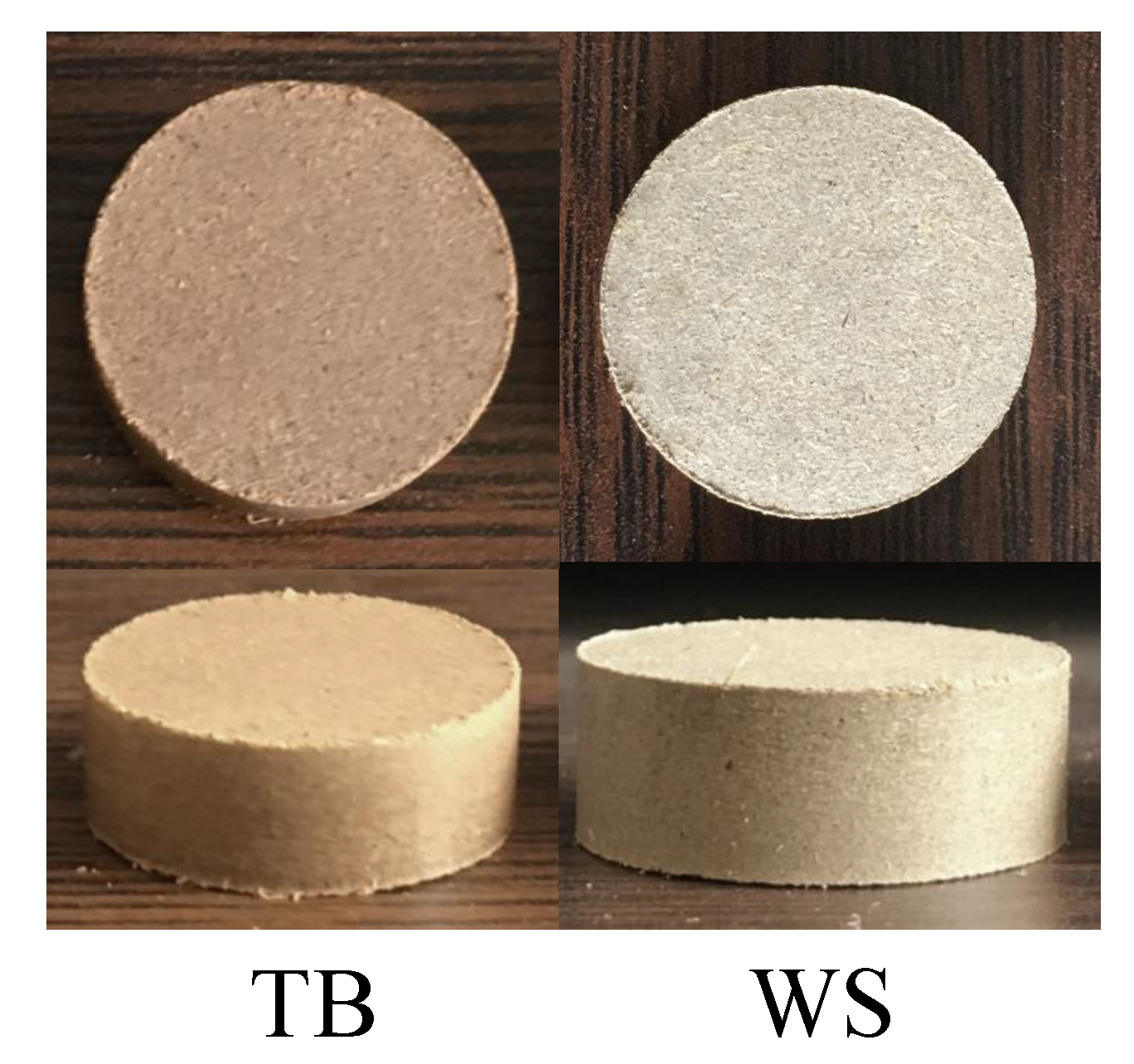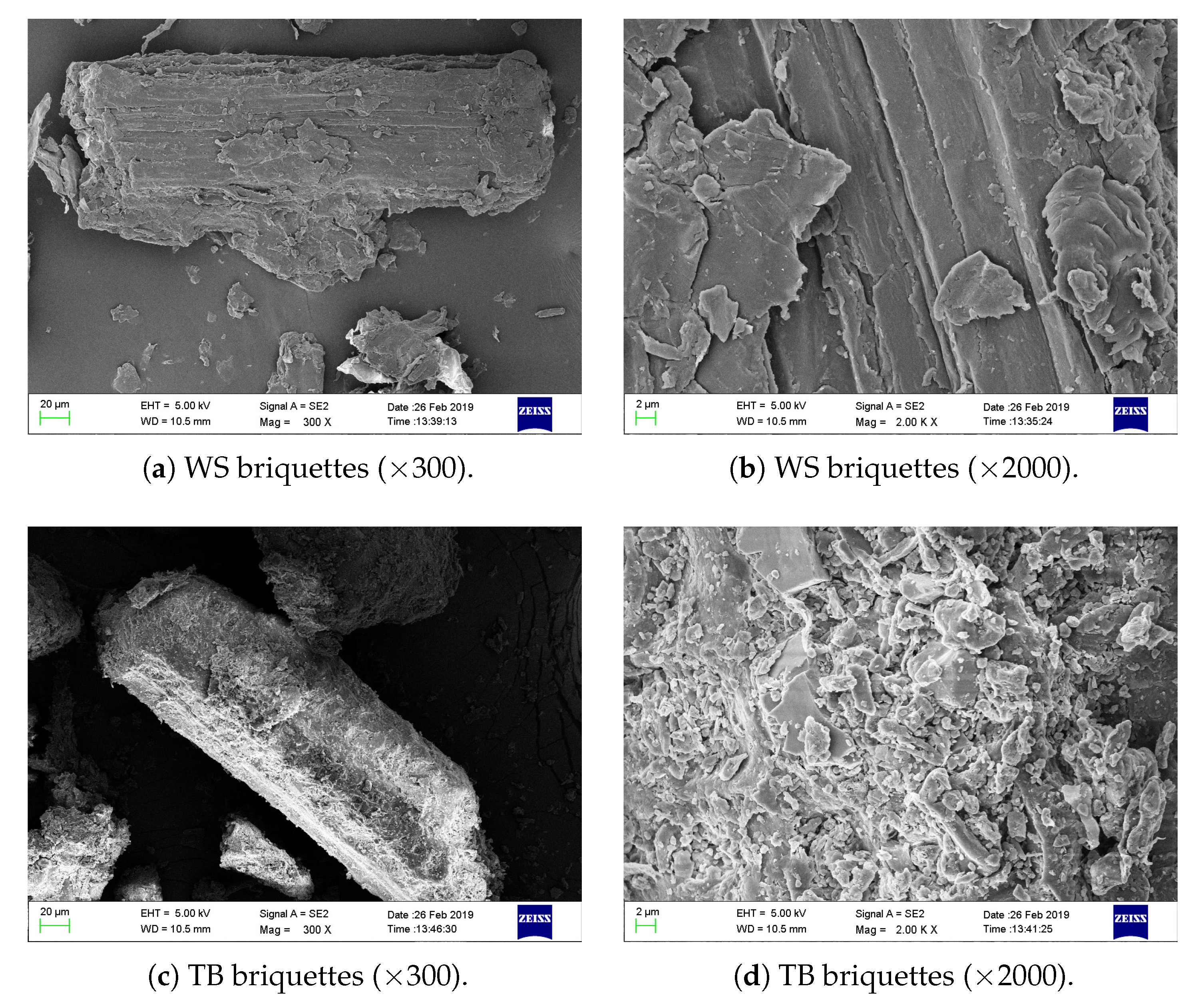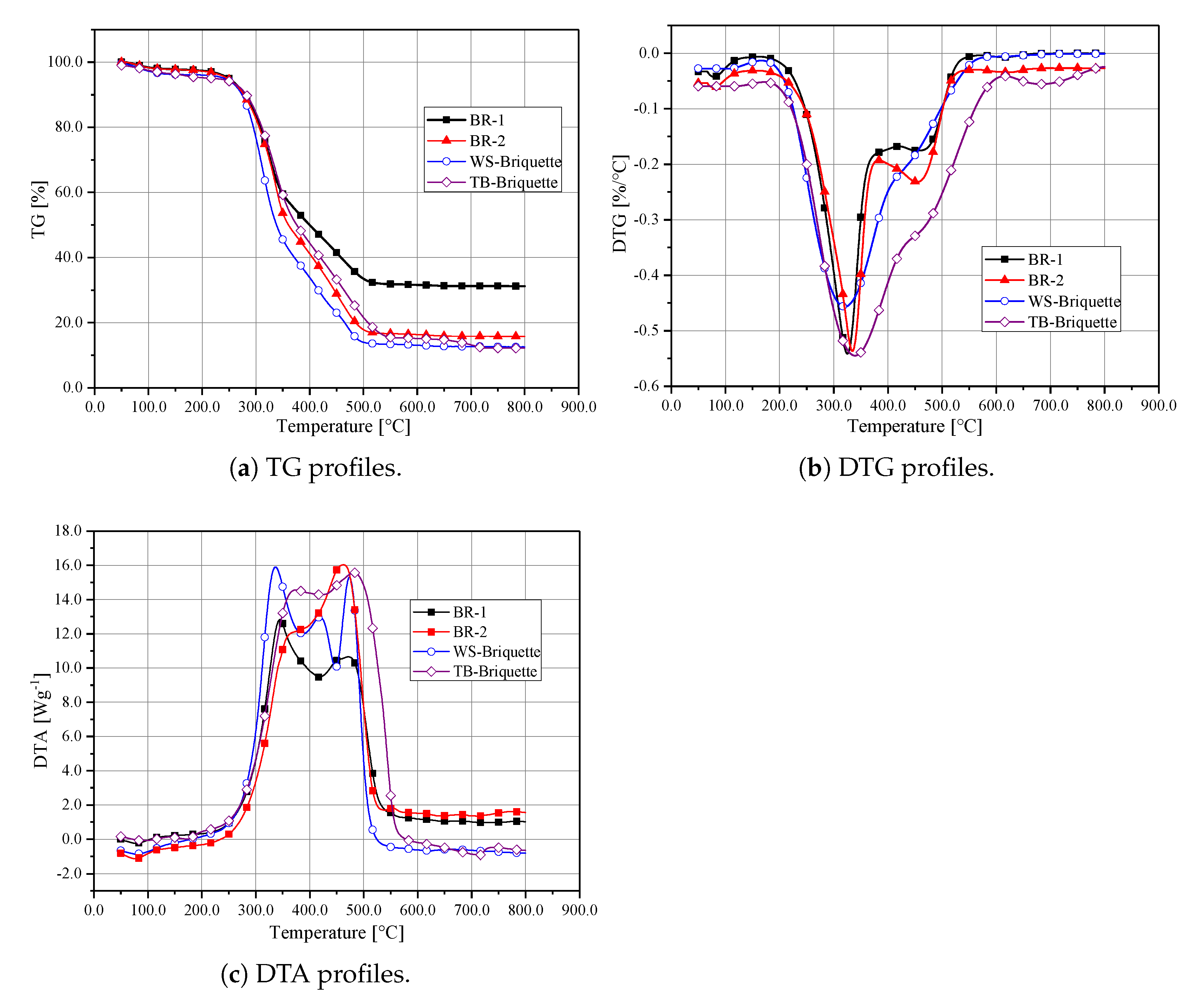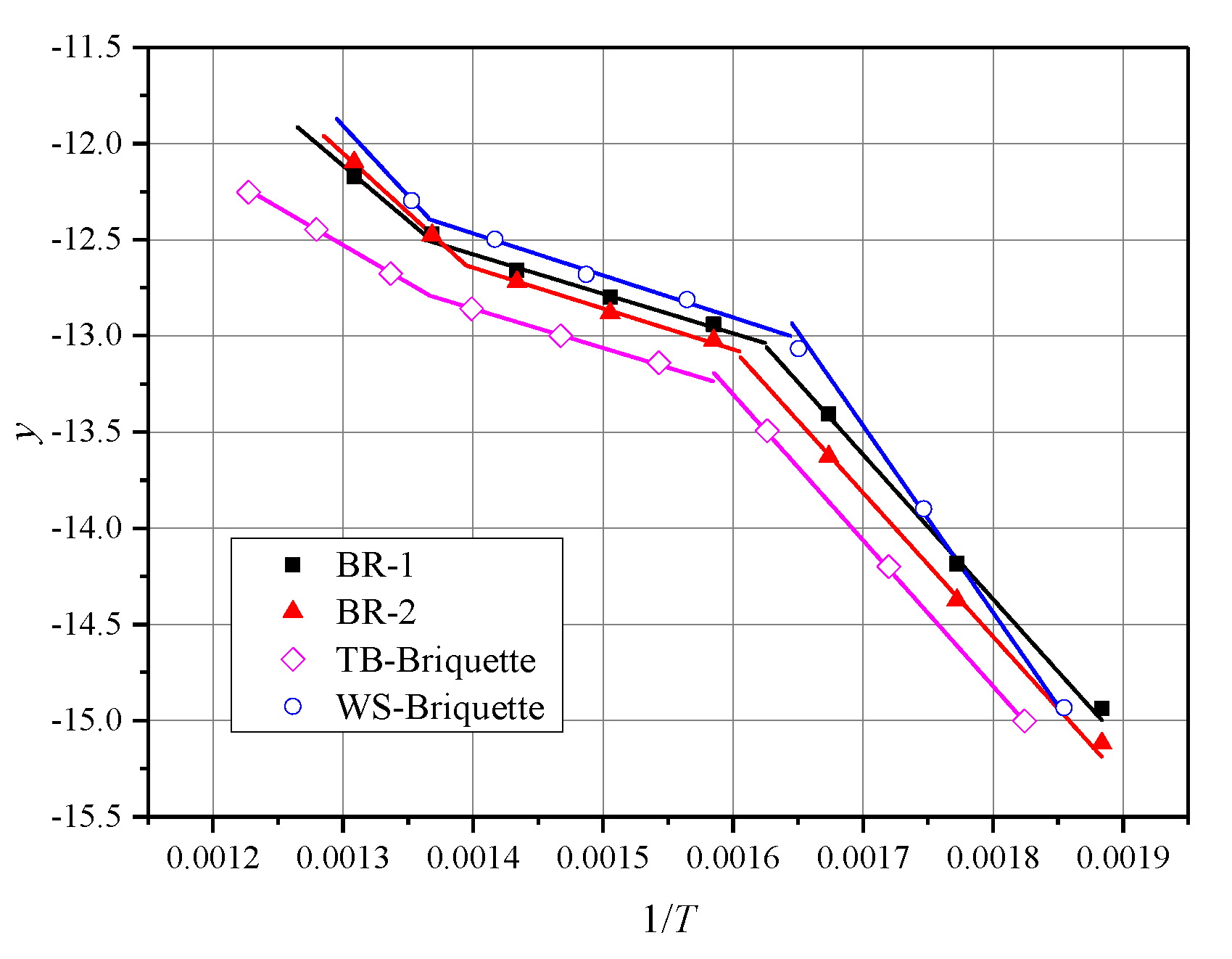Combustion Characteristics, Kinetics, SO2 and NO Release of Low-Grade Biomass Materials and Briquettes
Abstract
:1. Introduction
2. Experimental Methodology
2.1. Materials and Preparation
2.2. Briquetting Process
2.3. Experimental Methods
2.4. Thermogravimetric Analysis of Biomass Briquettes
3. Results and Discussion
3.1. Effects of Combustion Temperature
3.2. Effect of Briquetting Process on the SO2 and NO Reduction
3.3. Thermogravimetric Analysis Results
3.3.1. The Thermochemical Behaviours of Biomass Briquettes
3.3.2. The Kinetic Characteristic of Biomass Briquettes
4. Conclusions
Author Contributions
Funding
Institutional Review Board Statement
Informed Consent Statement
Data Availability Statement
Conflicts of Interest
Abbreviations
| BR | Obtained briquettes. |
| DTG | Differential thermogravimetric. |
| HHV | Higher heating value, []. |
| TB | Tree bulk. |
| TG | Thermogravimetric. |
| WS | Wheat straw. |
| The conversion rate of the sample, [%]. | |
| The heating rate, [ ]. | |
| Nitrogen conversion ratio, [%]. | |
| Sulphur conversion ratio, [%]. | |
| A | The pre-exponential factor, []. |
| The NO content at the time t, [ppm]. | |
| The SO2 content at the time t, [ppm]. | |
| The gas flue volume flow rate at time t, []. | |
| The ignition index, []. | |
| The maximum weight loss rate, []. | |
| E | The value of active Energy, []. |
| The differential conversion function. | |
| The reaction rate constant. | |
| S | The combustion characteristics index, []. |
| t | One specific experiment time, []. |
| The burnout temperature, []. | |
| The ignition temperature, []. | |
| The gas flue volume flow rate at time t, []. |
References
- Cheng, J. Biomass to Renewable Energy Processes; CRC press: Boca Raton, FL, USA, 2017. [Google Scholar]
- Qi, J.; Reddell, T.; Qin, K.; Hooman, K.; Jahn, I.H. Supercritical CO2 radial turbine design performance as a function of turbine size parameters. J. Turbomach. 2017, 139, 081008. [Google Scholar] [CrossRef]
- Wiselogel, A.; Tyson, S.; Johnson, D. Biomass feedstock resources and composition. In Handbook on Bioethanol; Routledge: Milton Park, UK, 2018; pp. 105–118. [Google Scholar]
- Pellegrini, A.F.; Pringle, R.M.; Govender, N.; Hedin, L.O. Woody plant biomass and carbon exchange depend on elephant-fire interactions across a productivity gradient in African savanna. J. Ecol. 2017, 105, 111–121. [Google Scholar] [CrossRef]
- Tenorio, A.T.; Kyriakopoulou, K.E.; Suarez-Garcia, E.; van den Berg, C.; van der Goot, A.J. Understanding differences in protein fractionation from conventional crops, and herbaceous and aquatic biomass-Consequences for industrial use. Trends Food Sci. Technol. 2018, 71, 235–245. [Google Scholar] [CrossRef]
- Shi, Y.; Ziadi, N.; Hamel, C.; Bittman, S.; Hunt, D.; Lalande, R.; Shang, J. Soil microbial biomass, activity, and community composition as affected by dairy manure slurry applications in grassland production. Appl. Soil Ecol. 2018, 125, 97–107. [Google Scholar] [CrossRef]
- Wang, T.; Li, Y.; Zhang, J.; Zhao, J.; Liu, Y.; Sun, L.; Liu, B.; Mao, H.; Lin, Y.; Li, W.; et al. Evaluation of the potential of pelletized biomass from different municipal solid wastes for use as solid fuel. Waste Manag. 2018, 74, 260–266. [Google Scholar] [CrossRef] [PubMed]
- Ghimire, A.; Trably, E.; Frunzo, L.; Pirozzi, F.; Lens, P.N.; Esposito, G.; Cazier, E.A.; Escudié, R. Effect of total solids content on biohydrogen production and lactic acid accumulation during dark fermentation of organic waste biomass. Bioresour. Technol. 2018, 248, 180–186. [Google Scholar] [CrossRef] [PubMed]
- Brown, R.C. Thermochemical Processing of Biomass: Conversion into Fuels, Chemicals and Power; John Wiley & Sons: Hoboken, NJ, USA, 2019. [Google Scholar]
- Wang, Q.; Han, K.; Gao, J.; Wang, J.; Lu, C. Investigation of maize straw char briquette ash fusion characteristics and the influence of phosphorus additives. Energy Fuels 2017, 31, 2822–2830. [Google Scholar] [CrossRef]
- Qi, J.; Han, K.; Wang, Q.; Gao, J. Carbonization of biomass: Effect of additives on alkali metals residue, SO2 and NO emission of chars during combustion. Energy 2017, 130, 560–569. [Google Scholar] [CrossRef] [Green Version]
- Medium and Long Term Development Plan for Renewable Energy Resources; National Development and Reform Commission: Beijing, China, 2007.
- Tumuluru, J.S. Biomass Volume Estimation and Valorization for Energy; BoD–Books on Demand: Norderstedt, Germany, 2017. [Google Scholar]
- Zhou, Y.; Zhang, Z.; Zhang, Y.; Wang, Y.; Yu, Y.; Ji, F.; Ahmad, R.; Dong, R. A comprehensive review on densified solid biofuel industry in China. Renew. Sustain. Energy Rev. 2016, 54, 1412–1428. [Google Scholar] [CrossRef]
- Niño, A.; Arzola, N.; Araque, O. Experimental study on the mechanical properties of biomass briquettes from a mixture of rice husk and pine sawdust. Energies 2020, 13, 1060. [Google Scholar] [CrossRef] [Green Version]
- Han, K.; Gao, J.; Qi, J. The study of sulphur retention characteristics of biomass briquettes during combustion. Energy 2019, 186, 115788. [Google Scholar] [CrossRef]
- Han, K.; Li, X.; Qi, J.; Zhu, Y.; Long, S.; Li, H.; Niu, S.; Li, S.; Xu, Y. Synergistic effect of additives and blend on sulfur retention, NO release and ash fusibility during combustion of biomass briquettes. Int. J. Green Energy 2021, 18, 187–202. [Google Scholar] [CrossRef]
- Sander, B.; Henriksen, N.; Larsen, O.; Skriver, A.; Ramsgaard-Nielsen, C.; Jensen, J.N.; Stærkind, K.; Livbjerg, H.; Thellefsen, M.; Dam-Johansen, K.; et al. Emissions, corrosion and alkali chemistry in straw-fired combined heat and power plants. In Proceedings of the 1st World Conference and Exhibition on Biomass for Energy and Industry, Sevilla, Spain, 5–9 June 2000. [Google Scholar]
- Li, Z.; Zhao, W.; Li, R.; Wang, Z.; Li, Y.; Zhao, G. Combustion characteristics and NO formation for biomass blends in a 35-ton-per-hour travelling grate utility boiler. Bioresour. Technol. 2009, 100, 2278–2283. [Google Scholar] [CrossRef] [PubMed]
- Krzywański, J.; Rajczyk, R.; Nowak, W. Model research of gas emissions from lignite and biomass co-combustion in a large scale CFB boiler. Chem. Process. Eng. 2014, 35, 217–231. [Google Scholar] [CrossRef]
- Krzywanski, J.; Czakiert, T.; Blaszczuk, A.; Rajczyk, R.; Muskala, W.; Nowak, W. A generalized model of SO2 emissions from large-and small-scale CFB boilers by artificial neural network approach Part 2. SO2 emissions from large-and pilot-scale CFB boilers in O2/N2, O2/CO2 and O2/RFG combustion atmospheres. Fuel Process. Technol. 2015, 139, 73–85. [Google Scholar] [CrossRef]
- Gangil, S. Beneficial transitions in thermogravimetric signals and activation energy levels due to briquetting of raw pigeon pea stalk. Fuel 2014, 128, 7–13. [Google Scholar] [CrossRef]
- Qi, J.; Li, H.; Han, K.; Zuo, Q.; Gao, J.; Wang, Q.; Lu, C. Influence of ammonium dihydrogen phosphate on potassium retention and ash melting characteristics during combustion of biomass. Energy 2016, 102, 244–251. [Google Scholar] [CrossRef]
- Wang, Q.; Han, K.; Qi, J.; Zhang, J.; Li, H.; Lu, C. Investigation of potassium transformation characteristics and the influence of additives during biochar briquette combustion. Fuel 2018, 222, 407–415. [Google Scholar] [CrossRef]
- Fang, M.; Shen, D.; Li, Y.; Yu, C.; Luo, Z.; Cen, K. Kinetic study on pyrolysis and combustion of wood under different oxygen concentrations by using TG-FTIR analysis. J. Anal. Appl. Pyrolysis 2006, 77, 22–27. [Google Scholar] [CrossRef]
- Han, K.; Wang, Q.; Zhao, J.; Luo, K.; Li, H.; Chen, Y.; Lu, C. Combustion pattern, characteristics, and kinetics of biomass and chars from segmented heating carbonization. Asia-Pac. J. Chem. Eng. 2016, 11, 812–822. [Google Scholar] [CrossRef]







| Sample | Proximate Analysis (W%) | Ultimate Analyses (W%) | HHV (MJ kg) | |||||||
|---|---|---|---|---|---|---|---|---|---|---|
| M | A | FC | V | C | H | O | N | S | ||
| BR-1 | 4.54 | 22.50 | 15.56 | 57.40 | 36.19 | 4.93 | 30.40 | 1.40 | 0.04 | 15.42 |
| BR-2 | 1.16 | 15.40 | 17.63 | 65.81 | 41.01 | 5.42 | 34.32 | 1.25 | 1.44 | 17.11 |
| WS | 5.88 | 10.12 | 16.20 | 67.82 | 34.80 | 5.15 | 40.14 | 3.53 | 0.38 | 17.61 |
| TB | 4.74 | 11.74 | 18.64 | 64.88 | 36.52 | 4.79 | 31.93 | 10.12 | 0.16 | 16.84 |
| Items | TB-Briquette | WS-Briquette | BR-1 | BR-2 |
|---|---|---|---|---|
| /[] | 287 | 273 | 278 | 282 |
| /[] | 795 | 567 | 666 | 656 |
| /[] | 339 | 320 | 325 | 334 |
| /[] | 0.380 | 0.457 | 0.541 | 0.667 |
| /[] | 683 | - | 455 | 454 |
| /[] | 0.023 | - | 0.176 | 0.269 |
| /[] | 0.174 | 0.299 | 0.221 | 0.232 |
| /[] | 1.302 | 1.744 | 1.996 | 2.361 |
| /[] | 0.112 | 0.360 | 0.258 | 0.329 |
| Samples | Temperature/[C] | Fitting Equations | E/[kJ mol] | A/[s] | |
|---|---|---|---|---|---|
| TB-Briquette | 275–358 | 32.67 | 0.78 | 0.999 | |
| 358–459 | 16.97 | 0.03 | 0.997 | ||
| 459–543 | 63.05 | 784.38 | 0.998 | ||
| WS-Briquette | 266–335 | 60.62 | 214.15 | 0.996 | |
| 335–459 | 18.15 | 0.06 | 0.992 | ||
| 459–499 | 80.71 | 67,489.77 | 0.997 | ||
| BR-1 | 258–342 | 47.51 | 17.55 | 0.997 | |
| 342–459 | 17.07 | 0.04 | 0.992 | ||
| 459–517 | 62.49 | 1082.76 | 0.999 | ||
| BR-2 | 258–350 | 51.15 | 35.61 | 0.994 | |
| 350–444 | 17.66 | 0.04 | 0.989 | ||
| 444–505 | 62.13 | 819.52 | 0.999 |
Publisher’s Note: MDPI stays neutral with regard to jurisdictional claims in published maps and institutional affiliations. |
© 2021 by the authors. Licensee MDPI, Basel, Switzerland. This article is an open access article distributed under the terms and conditions of the Creative Commons Attribution (CC BY) license (https://creativecommons.org/licenses/by/4.0/).
Share and Cite
Qi, J.; Li, H.; Wang, Q.; Han, K. Combustion Characteristics, Kinetics, SO2 and NO Release of Low-Grade Biomass Materials and Briquettes. Energies 2021, 14, 2655. https://doi.org/10.3390/en14092655
Qi J, Li H, Wang Q, Han K. Combustion Characteristics, Kinetics, SO2 and NO Release of Low-Grade Biomass Materials and Briquettes. Energies. 2021; 14(9):2655. https://doi.org/10.3390/en14092655
Chicago/Turabian StyleQi, Jianhui, Haopeng Li, Qian Wang, and Kuihua Han. 2021. "Combustion Characteristics, Kinetics, SO2 and NO Release of Low-Grade Biomass Materials and Briquettes" Energies 14, no. 9: 2655. https://doi.org/10.3390/en14092655






